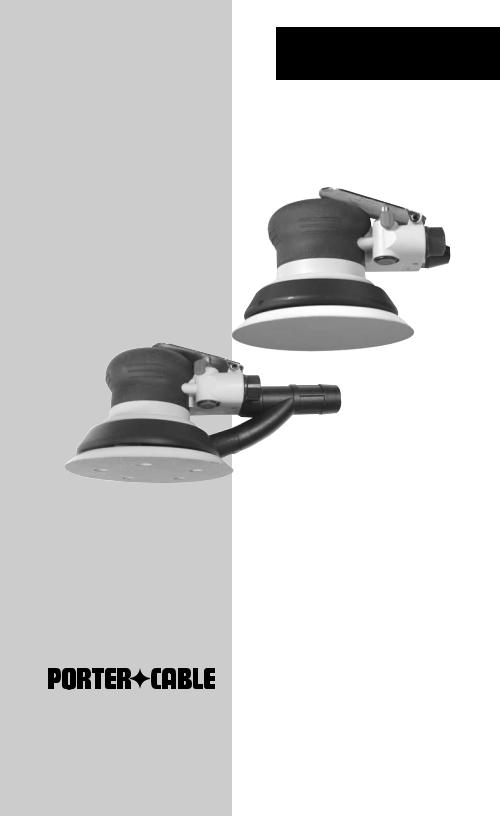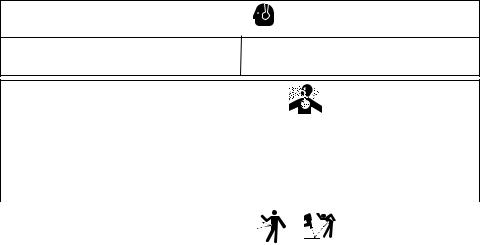Porter-Cable PTS10, PTS6, PTS3, PTS7, PTS4 User Manual
...
Instruction manual Manual de Instrucciones
Guide d'utilisation
ESPAÑOL: PÁGINA 11 FRANÇAIS: PAGE 19
Random Orbital Palm Sanders
Lijadora Orbital para la Palma de la Mano
Ponceuse orbitale aléatoire
To learn more about Porter-Cable visit our website at: http://www.porter-cable.com
Para obtener más información sobre Porter-Cable, visite nuestro sitio web en: http://www.porter-cable.com
Pour de plus amples renseignements concernant Porter-Cable, consultez notre site Web à l'adresse suivante: http://www.porter-cable.com
Copyright © 2003 Porter-Cable Corporation
MODEL/
MODELO/
MODÈLE
PTS3
PTS4
PTS5
PTS6
PTS7
PTS8
PTS9
PTS10
IMPORTANT
Please make certain that the person who is to use this equipment carefully reads and understands these instructions before starting operations.
IMPORTANTE
Asegúrese de que la persona que va a usar esta herramienta lea cuidadosamente y comprenda estas instrucciones antes de empezar a operarla.
IMPORTANT
Veuillez vous assurer que la personne qui utilise cet outil lit attentivement et comprend ces instructions avant de commencer à utiliser l'outil.
Part No. D29847-037-0

•Air powered equipment and power tools are capable of propelling materials such as fasteners, metal chips, saw dust, and other debris at high speed, which could result in serious eye injury.
•Tool attachments can become loose or break and fly apart propelling particles at the operator and others in the work area.
|
|
|
|
D29847 |
2- ENG |

HAZARD
 RISK OF LOSS OF HEARING
RISK OF LOSS OF HEARING
WHAT COULD HAPPEN |
HOW TO PREVENT IT |
• Long term exposure to noise produced from the opera- |
• Always wear ANSI S3.19 hearing protection. |
tion of air tools can lead to permanent hearing loss. |
|
HAZARD
 RISK TO BREATHING INHALATION HAZARD
RISK TO BREATHING INHALATION HAZARD
|
WHAT COULD HAPPEN |
HOW TO PREVENT IT |
|
• Abrasive tools, such as grinders, sanders, and cut-off |
• Always wear MSHA/NIOSH approved, properly fitting |
||
tools generate dust and abrasive materials which can |
face mask or respirator when using such tools. |
||
be harmful to human lungs and respiratory system. |
|
||
• Some materials such as adhesives and tar, contain |
• Always work in a clean, dry, well ventilated area. |
||
chemicals whose vapors could cause serious injury |
|
||
with prolonged exposure. |
|
||
|
|
|
|
|
HAZARD |
|
|
|
RISK OF INJURY |
|
|
|
|
||
|
|
|
|
|
WHAT COULD HAPPEN |
HOW TO PREVENT IT |
|
|
|
|
|
• Tools left unattended, or with the air hose attached can |
• Remove air hose when tool is not in use and store tool |
||
be activated by unauthorized persons leading to their |
in secure location away from reach of children and or |
||
injury or injury to others. |
untrained users. |
||
• Air tools can propel fasteners or other materials |
• Use only parts, fasteners, and accessories |
||
throughout the work area. |
recommended by the manufacturer. |
||
|
|
• Keep work area clean and free of clutter. Keep children |
|
|
|
and others away from work area during operation of |
|
|
|
the tool. |
|
|
|
• Keep work area well lit. |
|
• A wrench or a key that is left attached to a rotating part |
• Remove adjusting keys and wrenches before turning |
||
of the tool increases the risk of personal injury. |
the tool on. |
||
|
|
|
|
• Using inflator nozzles for duster applications can cause |
• DO NOT use inflator nozzles for duster applications. |
||
serious injury. |
|
||
|
|
|
|
• Air tools can become activated by accident during |
• Remove air hose to lubricate or add grinding |
||
maintenance or tool changes. |
attachments, sanding discs, drills, etc. to the tool. |
||
|
|
• Never carry the tool by the hose. |
|
|
|
• Avoid unintentional starting. Don't carry hooked-up tool |
|
|
|
with finger on trigger. |
|
|
|
• Repair servicing should be done only by an authorized |
|
|
|
service representative. |
|
• Air tools can cause the workpiece to move upon con- |
• Use clamps or other devices to prevent movement. |
||
tact leading to injury. |
|
||
|
|
|
|
• Loss of control of the tool can lead to injury to self or |
• Never operate tool while under the influence of drugs |
||
others. |
or alcohol. |
||
|
|
• Don't overreach. Keep proper footing and balance at all |
|
|
|
times. |
|
|
|
• Keep handles dry, clean, and free from oil and grease. |
|
|
|
• Stay alert. Watch what you are doing. Use common |
|
|
|
sense. Do not operate tool when you are tired. |
|
• Poor quality, improper, or damaged tools such as |
• Always use tool attachments rated for the speed of the |
||
grinding wheels, chisels, sockets, drills, nailers, |
power tool. |
||
staplers, etc., can fly apart during operation, propelling |
• Never use tools which have been dropped, impacted or |
||
particles throughout the work area causing serious |
|||
damaged by use. |
|||
injury. |
|||
• Use only impact grade sockets on an impact wrench. |
|||
|
|
||
|
|
• Do not apply excessive force to the tool, let the tool |
|
|
|
perform the work. |
|
|
|
|
|
3- ENG |
D29847 |
